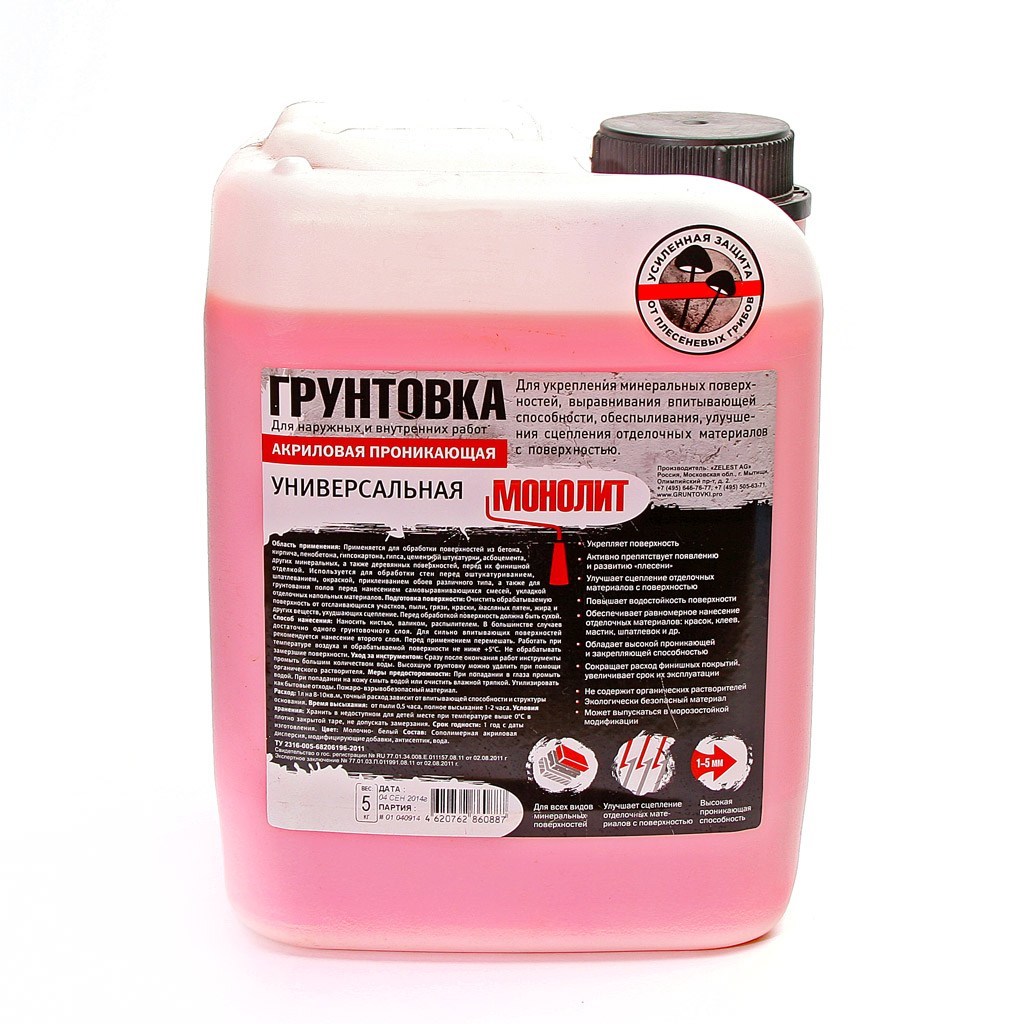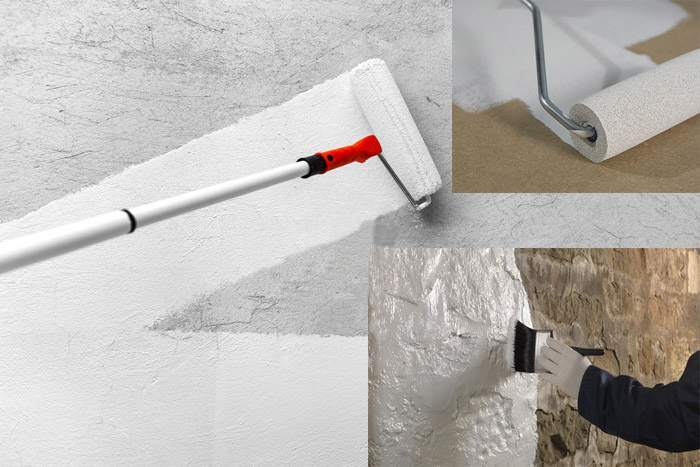Content
- Why do I need a primer
- Types of primers
- Primer drying time
- Primer walls for different coatings: stages of work
Padding It is an important preparatory stage before any finishing work. In order to properly plan your time and make repairs efficiently, it is important to know how much the primer dries, what type of composition Suitable for the walls or ceiling of your apartment, after how long after priming you can start gluing wallpaper or painting walls.

Why do I need a primer
Primer is a special emulsion, the main purpose of which is to improve the adhesion, or adhesion, coating to the treated surface. In addition, a special primer impregnates the upper layers of the base, enhancing strength and increasing wear resistance. It is used for processing floors, ceilings and walls, when working inside and outside buildings. It must be applied to the surface before painting or wallpapering.
Additional primer functions:
- protection of metal from rust;
- the manifestation of the pattern on wooden materials;
- reduced absorption capacity of surfaces;
- preventing the development of mold and fungus under the wallpaper;
- traction for smooth slippery surfaces.

The composition of the primer emulsion includes natural, synthetic, liquid or solid film-forming materials: drying oil, alkyd and epoxy resins. Sometimes fillers are added - talc, chalk.
The primer is applied to the treated base with a spatula, roller, brush. The process of applying the emulsion is called priming.
Before priming, preparatory work is necessarily carried out - cleaning the surface of the walls from paint, shabby wallpaper, and if necessary - degreasing with a solvent.
USEFUL INFORMATION:How to sheathe a ceiling with a clapboard?
Types of primers
The building materials market offers a solid selection of primers from different manufacturers. Primer mixes differ in composition, purpose and drying time, can be universal and special, for indoor or outdoor use.
According to the properties and purpose of the primer can be divided into the following types:
- Concrete contact - the mixture includes quartz sand, cement, other fillers, an acrylic binder is the basis of the composition. It is intended to increase the adhesion of a smooth, slightly absorbent surface (concrete, tile, old paint) with plasters, putties, adhesive for ceramic tiles.

- Penetrating universal - prepares surfaces before tiling, painting. Strengthens loose, crumbling bases and reduces their absorption capacity.

- Colorless - used for processing wooden surfaces in order to preserve the natural structure of wood. Forms a waterproof film that protects the tree from decay.

- Contact - enhances the ability of a solid surface to “bond” with various solutions (paints, adhesives).

- Film-forming - used in work with problematic surfaces. Strengthens the base, creates a film that limits the flow of moisture. It can be applied on any surface, from cement floors to fiberboard. It dries quickly, which is convenient when deciding to glue wallpaper on the walls.

Primer drying time
The minimum period of time during which the primer dries up is 4 hours, the maximum is a day. Despite the fact that the package always contains information about how much the primer dries, the waiting time after its application can vary, and quite significantly.
USEFUL INFORMATION:What to choose, wallpaper or wall painting?
Factors affecting the drying speed of the primer:
- The consumption of the mixture and the thickness of the layer - depend on the condition of the surface being treated. There are walls that require repeated priming or applying the composition in a thick layer.
- Type of primer - acrylic emulsions are quick-drying, they need 3-4 hours to dry, oil or contact ones dry up to 24 hours.
- The type of surface to be treated - porous and dry, dries quickly, and with freshly applied plaster - about 12 hours.
- The temperature in the building and the humidity level - the lower the air temperature in the rooms and the higher the humidity, the longer the drying period of the primer. For example, after applying concrete contact on the walls at a temperature of 23 ° C and a relative humidity of 50%, you can start wallpapering through 12 hours, and when the temperature drops to 20 ° C and the air humidity rises to 65%, finishing work can only be started after day.

Tip: you can speed up the drying time of the primer by increasing the temperature in the room with the help of heating devices. To reduce humidity, it is enough to open the door or window and arrange natural ventilation.
Primer walls for different coatings: stages of work
The priming of various surfaces has differences and its own specifics. You can skip this step and after cleaning the walls immediately stick on them wallpaper or paint without pre-treatment. After some time, this can lead to a deplorable result: the paint will begin to crumble, mold will come out through the wallpaper, or with subsequent repairs, you simply can not remove them from the wall.
Primed walls for wallpaper:
- The previous finish is carefully removed (old wallpaper, plaster, cracked oil paint).
- Small cracks and bumps in the walls are sealed with putty.
- The surface is carefully treated with a deep penetration primer (there should be no dry places).
- The time of complete drying of the emulsion is maintained. How long does the primer dry before starting wallpapering? On average, after 5-6 hours at an air temperature of 24 ° C and a humidity of 60%, the surfaces are ready for finishing work. It is recommended that the drying period indicated by the manufacturer of the particular brand of primer be observed.
USEFUL INFORMATION:Secrets of preparing walls for wallpapering

Before gluing the wallpaper, be sure to sweep your hand along the walls - if there is a trace of putty on your palm, apply another layer of primer.
Primer Ceiling:
- The old whitewash, paint is carefully removed.
- The surface is wiped with a damp sponge and dried.
- The ceiling is covered with a primer emulsion. If there is no ladder, attach the roller to a long, level stick.
When the thin coat of primer dries, you can continue the finishing work.

EXPERT SITE
Tsugunov Anton Valerevich
Master Station Wagon
- Since 2003, I have been engaged in the repair and decoration of premises.
- Over 100 completed objects.
- I appreciate the quality, more than the quantity!
Personal page >>>
Friends!
I offer you the service "Friend Builder"
As this site develops, subscribers and visitors are turning to me more and more often asking for help with advice on various issues of repair and decoration.
Questions are sometimes asked very complex and interesting. You can’t write an article for each situation, so I decided to advise you individually.
Thanks to you, friends, a new direction of my favorite work has been born - share your experience and benefit everyone who is undergoing repairs!
Get a one-time consultation from me >>>
Order full apartment repair support >>>

